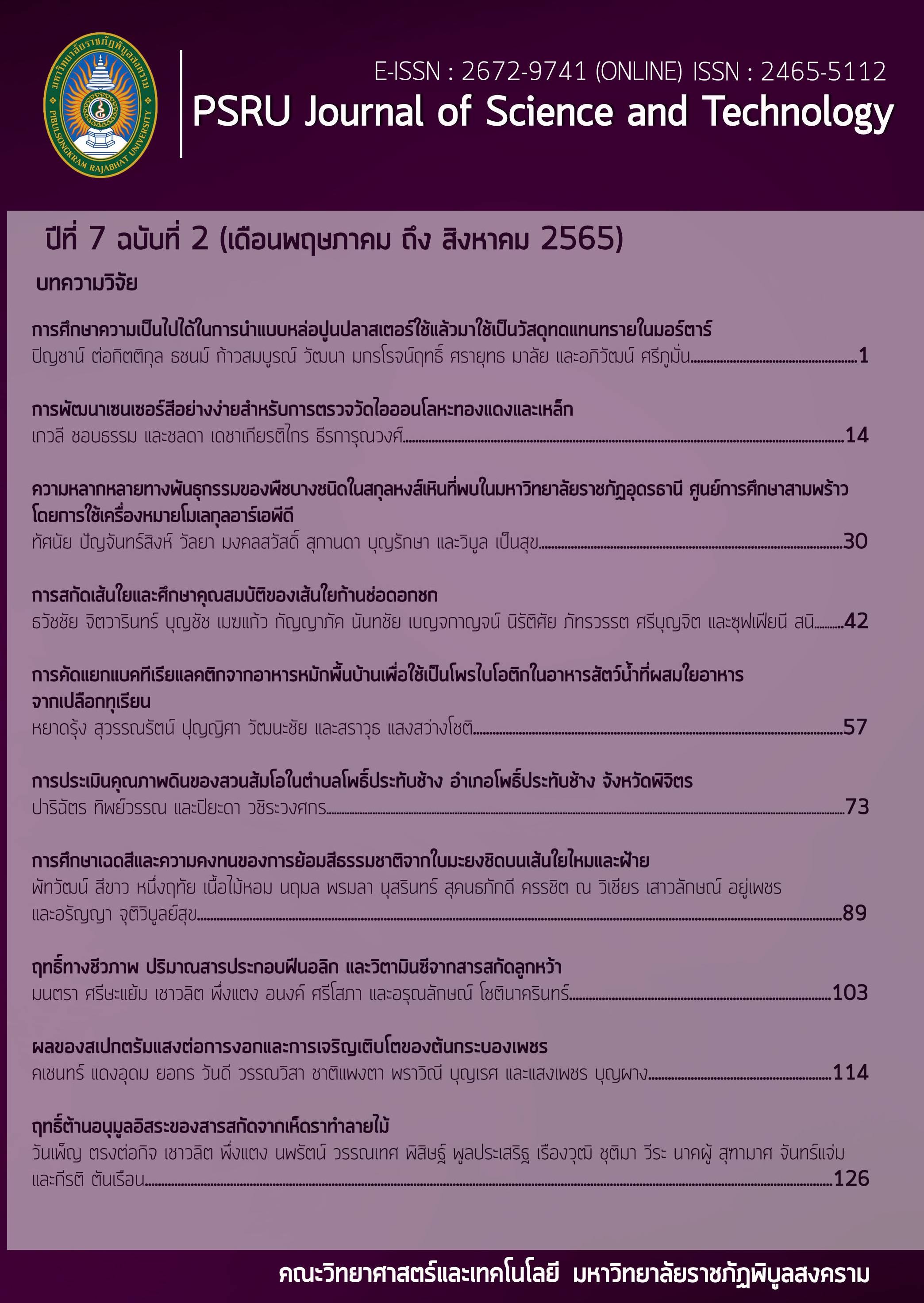THE PRELIMINARY INVESTIGATION OF USING WASTE PLASTER GYPSUM MOLD AS SAND REPLACEMENT MATERIAL IN MORTAR
Keywords:
Waste plaster gypsum mold, Sand replacement, Mortar, Compressive strength, Thermal conductivityAbstract
This research aims to study the possibility of using waste plaster gypsum mold from
the ceramic industry in Lampang Province to produce wall materials. Waste plaster gypsum mold was ground and sieved to keep similar particle size distribution to those of sand. The ground plaster gypsum was then replaced with sand in the mortar at 10, 30, 50, 60, 80, 90, and 100 percent by volume. The effect of waste plaster gypsum on physical, mechanical, and thermal properties was carried out. The results showed that compressive strength, tensile strength and flexural strength were decreased with the increasing amount of waste plaster gypsum. The compressive strength of mortars with the replacement of waste plaster gypsum at 50 and 100 percent by volume at 28 days was 10.50 and 7.00 Megapascal, respectively. However, the thermal conductivity of mortar containing 100 percent waste plaster gypsum was 0.38 Watts per meter per Kelvin, which was reduced by 78 percent compared to that of the control mortar. It achieved a density approximately at 1.60 gram per cubic centimeter. Therefore, waste plaster gypsum as sand replacement material might result in a lightweight wall block with suitable thermal insulation properties.
References
กรมโรงงานอุตสาหกรรม (2551). ข้อมูลวัสดุเหลือทิ้งจากโรงงานอุตสาหกรรมเซรามิก. กรุงเทพฯ: สำนักบริหารจัดการกากอุตสาหกรรม.
มยุรี ปาลวงศ์. (2552). ประโยชน์ของยิปซัม. กรุงเทพฯ: หจก. ไอเดีย สแควร์.
Alencar, L.H., Mota, C.M., & Alencar, M.H. (2011). The problem of disposing of plaster waste from building sites: Problem structuring based on value focus thinking methodology. Waste Management, 31, 2512–2521.
Camarini, G., Pinto, M.C.C., Moura, A.G.M., & Manzo, N.R. (2016). Effect of citric acid on properties of recycled gypsum plaster to building components. Construction and Building Materials, 124, 383-390.
Cao, W., Yi, W., Peng, J., Li, J., & Yin, S. (2022). Recycling of phosphogypsum to prepare gypsum plaster: Effect of calcination temperature. Journal of Building Engineering, 45, 103511.
Chandara, C., Azizli, K.A.M., Ahmad, Z.A., & Sakai, E. (2009). Use of waste gypsum to replace natural gypsum as set retarders in Portland cement. Waste Management, 29, 1675–1679.
Erbs, A., Nagalli, A., Carvalho, K.Q., Mazer, W., Erbs, M.M., Paz, D.H.F., & Lafayette, K.P.V. (2021). Development of plasterboard sheets exclusively from waste. Journal of Building Engineering, 44, 102524.
Geraldo, R.H., Souza, J.D., Campos, S.C., Fernandes, L.F.R., & Camarini, G. (2018) Pressured recycled gypsum plaster and wastes: Characteristics of eco-friendly building components. Construction and Building Materials, 191, 136-144.
Guan, B., Kong, B., Fu, H., Yu, J., Jiang, G., & Yang, L. (2012). Pilot scale preparation of a-calcium sulfate hemihydrate from FGD gypsum in Ca–K–Mg aqueous solution under atmospheric pressure. Fuel, 98, 48–54.
Guan, B., Yang, L., Fu, H., Kong, B., Li, T., & Yang, L. (2011). -calcium sulfate hemihydrate preparation from FGD gypsum in recycling mixed salt solutions. Chemical Engineering Journal, 174, 296–303.
Gutiérrez-González, S., Gadea, J., Rodríguez, A., Blanco-Varela, M.T., & Calderón, V. (2012). Compatibility between gypsum and polyamide powder waste to produce lightweight plaster with enhanced thermal properties. Construction and Building Materials, 34, 179-185.
Ismail, B., Belayachi, N., & Hoxha, D. (2020). Optimizing performance of insulation materials based on wheat straw, lime and gypsum plaster composites using natural additives. Construction and Building Materials, 254, 118959.
Kangavar, M.E., Lokuge, W., Manalo, A., Karunasena, W., & Frigione, M. (2022). Investigation on the properties of concrete with recycled polyethylene terephthalate (PET) granules as fine aggregate replacement. Case Studies in Construction Materials, 16, e00934.
Li, Z., Xu, K., Peng, J., Wang, J., Ma, X., & Niu, J. (2019). Study on hydration and mechanical property of quicklime blended recycled plaster materials. Construction and Building Materials, 202, 440-448.
Ouakarroucha, M., Azharya, K.E., Laaroussi, N., Garoum, M., & Kifani-Sahban, F. (2020). Thermal performances and environmental analysis of a new composite building material based on gypsum plaster and chicken feathers waste. Thermal Science and Engineering Progress, 19, 100642.
Pedreno-Rojas, M.A., De Brito, J., Flores-Colen, I., Pereira, M.F.C., & Rubio-de-Hita, P. (2020). Influence of gypsum wastes on the workability of plasters: Heating process and microstructural analysis. Journal of Building Engineering, 29, 101143.
Pereira, V.M., Geraldo, R.H., Cruz, T.A.M., & Camarini, G. (2021). Valorization of industrial by-product: Phosphogypsum recycling as green binding material. Cleaner Engineering and Technology, 5, 100310.
Rivero, A.J., Báez, A.G., & Navarro, J.G. (2014). New composite gypsum plaster – ground waste rubber coming from pipe foam insulation. Construction and Building Materials, 55, 146-152.
Sadique, M., Nageim, H.A., Atherton, W., Seton, L., & Dempster, N. (2012). A new composite cementitious material for construction. Construction and Building Materials, 35, 846–855.
Torkittikul, P., Nochaiya, T., Wongkeo, W., & Chaipanich, A. (2015). Utilization of coal bottom ash to improve thermal insulation of construction material. Journal of Material Cycles and Waste Management, Doi: 10.1007/s10163-015-0419-2.
Waseem, S.A., Thakur, N., Islam, S., Kumar, M., & Saini, J.S. (2021). Cupola slag as partial replacement of fine aggregate in concrete – An experimental study. Journal of Building Engineering, 44, 103343.
Downloads
Published
How to Cite
Issue
Section
License
Copyright (c) 2022 PSRU Journal of Science and Technology

This work is licensed under a Creative Commons Attribution-NonCommercial-NoDerivatives 4.0 International License.
กองบรรณาธิการขอสงวนสิทธิ์ในการปรับปรุงแก้ไขตัวอักษรและคำสะกดต่างๆ ที่ไม่ถูกต้อง และต้นฉบับที่ได้รับการตีพิมพ์ในวารสาร PSRU Journal of Science and Technology ถือเป็นกรรมสิทธิ์ของคณะวิทยาศาสตร์และเทคโนโลยี มหาวิทยาลัยราชภัฏพิบูลสงคราม และ
ผลการพิจารณาคัดเลือกบทความตีพิมพ์ในวารสารให้ถือมติของกองบรรณาธิการเป็นที่สิ้นสุด







